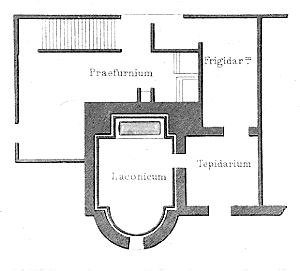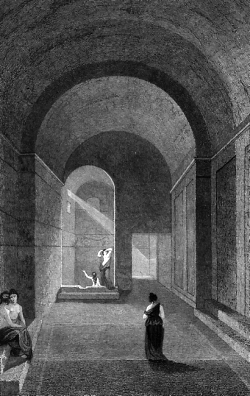Chapter VII - Women's Baths |
|
The abuses of promiscuous bathing had become so
flagrant, that Spartianus says Hadrian ordered the
separation of the sexes, which had, however, been done
ineffectually before. Eunuchs were appointed to attend
in the women's baths, as Lampridius observes ; and a
Roman law makes the offence of forcibly entering the
women's baths by a man capital. «Vir qui thermas
mulieribus discretas violenter intrare praesumpsisset
capite puniretur». |
Vitruvius, Book V, shows that the baths of the two sexes
were not, even in his time, the same, though, for the
convenience of the stoves, they were contiguous.
«Uti calidaria muliebria viriliaque conjuncta, et in
iisdem regionibus sint collocata, sic enim efficiebatur uti
vasaria ex hypocausto communis sit eorum».
The baths of Baden, cited by Wilkins in his Vitruvius, were
double ; those of the females being an exact repetition of
the men's apartments. Without relying too much on the
information of Vitruvius, who says that the baths of the
women were on the right of the furnace, it seems highly
probable that the females of Pompeii, without waiting for an
hour set apart, had baths consecrated to their exclusive use
; and, if so, the chambers marked in the plan 3, 4, and 5,
seem those best adapted to their purposes.
Bonucci, in his instructive work, has imagined these to have
constituted the male thermae ; but only from a
sentiment of modern gallantry which would assign to the
ladies the handsomer apartment ; whereas it would appear,
that a smaller and less airy suite of chambers would have
been equally convenient for the women, who did not, like the
men, spend half their lives at the bath, but only frequented
it for the purposes of health or cleanliness.
It might also be supposed that ladies of rank had, as at Rome
and at the villa of Diomedes, in the suburb of Pompeii, their
own baths, so that females of consequence were not seen at
the public thermae ; but, be that as it may, we find
in the little room, 1, a place where either towels or clothes
were dried or suspended. In the room 3, or
frigidarium, we find a cold bath or natatorium,
2.
In the next chamber, 4, is the tepidarium ; and that
marked 5 is the laconicum, with its caldarium
or hot water, 7 ; and, below it, is a stove, 6, or hypocaust,
for heating the whole. Near the entrance is painted in red
letters
M. C. V. VB. AED. OVF. COLEPIVS
ROG SICARIO
All the rooms yet retain, in perfection, their vaulted roofs.
|
The first chamber is twenty-five feet long, plate
XXXIII, by twelve feet nine inches. The view seems, at
first sight, defective in perspective on the left ; but
the room is, in one part, one foot six wider than the
other. The piscina, or bath, is six feet eight
wide in front, by seven feet four in breadth. The floor
is in white mosaic, with a little border of black. The
walls have been ornamented with yellow pilasters, on a
blue or black ground. |
The whole is vaulted, and, perhaps, there may have been a cistern or reservoir above the arch. A vase, or solium, or labrum, at the north end of this chamber is much ruined, but may have served for hot or cold water, or any of the purposes to which such vessels were applicable.

Plate 34 - Commentary |
The court or yard, 8, may have been the place where wood
was piled for burning ; and two rude pillars, yet standing,
may have supported a roof of tiles for keeping it dry. A
flight of stairs ran hence to the roof of the baths, which
retained, when discovered, their original covering of plaster
or stucco.
On the right of the entrance into these women's baths, is a
stone wall of good masonry and singular thickness.
In the alley, or vicus, on the outside of this is the
mark of a sort of gutter to direct the falling water either
from the roof or the cistern.
It is supposed that there was an arched or other connexion
between the therma and the buildings on the other side
of this vicus, opposite the house of Pansa.
We have now given an account of the different parts of the
thermae, and endeavoured to apply to the remains the
discordant and unintelligible accounts of the ancients, all
the fragments of which have been collected in the works
reedited by Groevius and Gronovius.
The subject has unavoidably led to a protracted dissertation,
for which the apology must be the interesting, and hitherto
unsuccessfully attempted, adjustment of facts to
localities.
The public vas informed, by a bell placed above the
thermae, when the water was heated, and the baths
open. When a certain hour was passed, the fires were
extinguished. The hour for bathing, according to Pliny, was
eight in winter, and nine in summer ; but this must have
frequently varied. Julius Capitolinus relates that, before
the time of Alexander Severus, the thermae were not
opened before daylight, and were closed before night ; and
Hadrian made a law, that those who bathed on account of any
infirmity should have the use of the public thermae
only till the eighth hour.
The baths were closed, as are modern theatres, on occasions
of public mourning, according to Livy ; and a very serious
inconvenience it must have been to a people who thought
themselves entitled to eat a second dinner after
perspiration, and seem to have passed the greater part of
their lives at the thermae.
As fashions changed, sonne physicians, according to Pliny,
attacked the practice of bathing. Thessalus, in the time of
Nero and Charmis, wrote against it ; but Telephus, the
grammarian, says Galen, bathed twice a month in winter, three
times a month in spring, and four times a month in summer,
and lived, in consequence, to the age of one hundred without
disease.
Baths, by which are understood prepared baths, are mentioned
in the East by the sacred writers, and by Homer. Vegetius
says, however, that the senate formed the Campus Martius near
the Tiber, that, after exercising, the Roman youth might
bathe : and, in 440 U. C. we are told by Festus Pompeius, and
not before, a piscina publica was constructed
«ad Clivum Capitolinum juxta Tiberim». But this
only provided for the first and most simple part of the
process. The names of the parts of the thermae were
all Greek, and derived, with the invention, from that people.
Socrates, Plato, and Aristotle talk of baths as common ; and
Hippocrates, about the time of the Peloponnesian war,
recommends their use. About the time of Augustus, baths were
innumerable in Rome ; and we see, by the splendid work of Mr
Lysons, that even the Roman villas of England possessed
them.
In process of time, some of the baths in the capital were
found unnecessary. Aurelius shut up several. Heliogabalus,
among other caprices, bathed only once in some of the baths
and then destroyed them. They seem to have been used, more or
less, in Europe till the wars of the Vandals, Goths, Huns,
and Longobardi, after which the ruined thermae were
frequently converted into churches.
It is probable that the thermae often became the
favourite resort of the vicious and the profligate, and, as
such, liable to the animadversions and reprehensions of the
fathers of the church, whence the name of bagnio has become
synonymous with brothel in our own language. J. B. Casalius,
who has written a treatise «De Thermis et Balneis
veterum», says that, as Christianity prevailed, the
taste for ablution diminished. It is curious that a
superstition should have prevailed according to which those
who had been baptized were supposed no longer to stand in
need of washing. Casalius cites authors who affirm that a
whole nation, on the confines of Armenia, was, by nature,
stinking ; and a patriarch of Constantinople refused baptism
to some who sought it, not from conscientious motives, but
merely as an easy way of sweetening their persons. Fortunatus
is cited, who talks of Jews christened by St. Avitus in the
year 579, who, from exhaling an unsavoury odour, became, by
the operation of the ceremony, perfectly ambrosial.
It is probable, however, that the thermae were
destroyed or neglected during the troubles of the middle ages
; but it is somewhat remarkable, that when the Spaniards
attempted, by force, the conversion of the Moors of Granada,
Marmol, p. 133, vol. I. declares, that, in the furtherance of
this object, not only were they forbidden the use of their
own language and dress by the emperor Don Carlos, but baths,
either in public or in private, were especially prohibited to
persons of every condition, and those which existed, even in
private houses, were ordered to be destroyed.
The head and tail pieces of this chapter represent the plans
of two baths excavated in the last century at Stabiae. There
can be little doubt that, on coming to the pavement of the
natatorium encircling the piscina, the workmen
thought they had found the bottom, though the vase was yet
filled with earth. These plans were in the possession of
Signor Carlo Bonucci in the year 1827.
These are supposed to have appertained to some of the villas
which occupied the site of the deserted city of Stabiae. A
section of the laconicum of one of these
thermae has been preserved by La Vega, who was
employed in the excavations, so exactly similar to that which
is given in this work as the laconicum at Pompeii,
that the publication of it might have forestalled all the
information now acquired by the recent discoveries.

Vignette 16 - Commentary |

